|
|
|
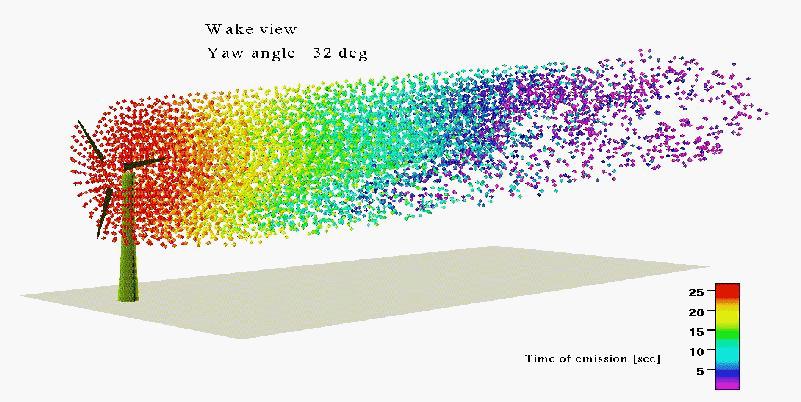
Unsteady aerodynamics play an important role in the design of wind turbines. Situations as pitch steps, safety stops, yaw misalignment (static and dynamic) can give important overshoots. Aiming at refined and better designs in terms of performance, reliability and cost, such situations must be well understood. Experiments both in site and in laboratory, although are of great importance, they cannot on their own give complete information. This is where modelling plays a critical role. Numerical simulations combined with measurements constitute a consistent basis for the analysis and design of wind turbines.
 To improve our understanding on the underlying flow mechanisms,
by means of detailed model.
To improve our understanding on the underlying flow mechanisms,
by means of detailed model.
 To investigate the impact of dynamic inflow on the loading
and unsteady aerodynamics of wind turbines.
To investigate the impact of dynamic inflow on the loading
and unsteady aerodynamics of wind turbines.
 To check the confidence limits of the prediction tools through
comparisons with measurements.
To check the confidence limits of the prediction tools through
comparisons with measurements.
 To provide a complete data base of results from simulations.
To provide a complete data base of results from simulations.
The flow around a wind turbine rotor is an unsteady non-linear, threedimensional flow. From the physical point of view, the correct framework to study are the unsteady Navier-Stokes equations. Because their solution is beyond our current capabilities, a less complex model must be used.
GENUVP, a free wake aerodynamic model, was selected to be the basic computational tool for our work. It models the blades as thin lifting surfaces, whereas the tower as well as the nacelle are implemented as non-lifting bodies. The wakes of either the blades or the tower are considered as regions of distributed vorticity. Freely moving vortex particles are used to approximate all wakes. Recently, stall modelling has been added based on the double wake concept: vorticity is shed not only along the trailing edge and tip, but also along the leading edge.
The coupling between the free wake model and a beam elastic model gives the ability to provide predictions of the rotor aeroelastic performance in the time domain. The coupling is non-linear and consists of :
The model was evaluated against wind tunnel as well as full scale measurements. Being unsteady and without simplified assumptions concerning the flow development, GENUVP can give detailed information in the wake of a wind turbine.
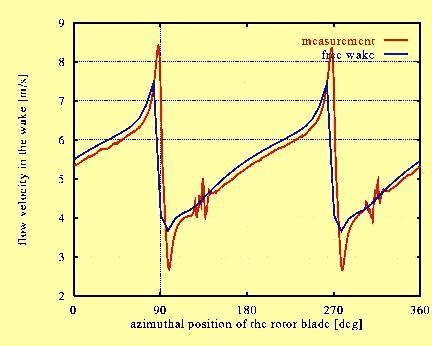 (a)
(a)
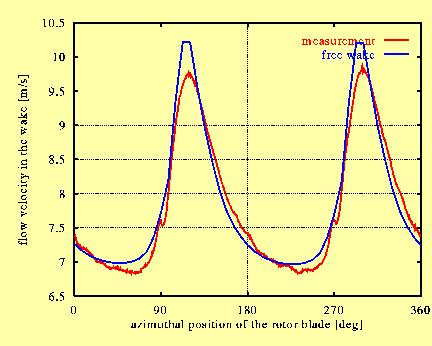 (b)
(b)
Wind tunnel test case: DUT rotor, TSR=6, velocity time traces in the wake, at x/R=0.053 downstream the rotor and at radial positions (a) y/R=0.8, (b) y/R=1.05.
Fast pitch steps and yaw misalignment can cause significant overshoots, that play an important role in the estimation of the fatigue loading lifetime of the rotor. GENUVP proved to give consistent and reliable predictions for the axial force effecting on the rotor and the horizontal flow velocity in the wake as compared against measurements.
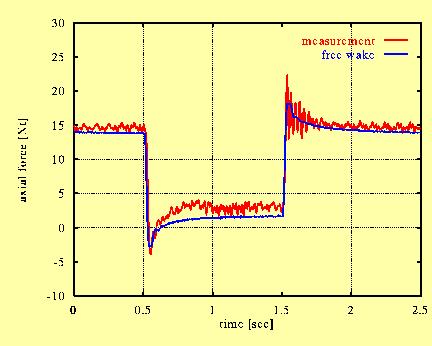 (a)
(a)
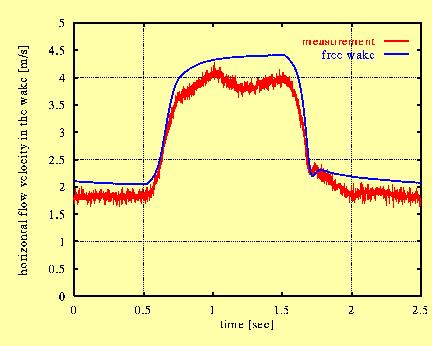 (b)
(b)
Time traces of the axial force and horizontal velocity in the wake of the DUT rotor during pitch stepping from 0 to 8 o and reverse at TSR=8.
Full scale tests of pitch steps and extreme yawed operation for the TJAEREBORG 2MW wind turbine were considered. Comparing models of varying complexity with measure-ments, it was found that correct overshoots (or equivalently ranges in the fatigue terminology) can be obtained. The free wake model seems to be closer to reality at least in its details.
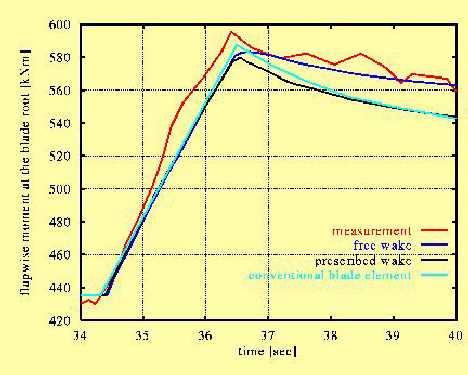
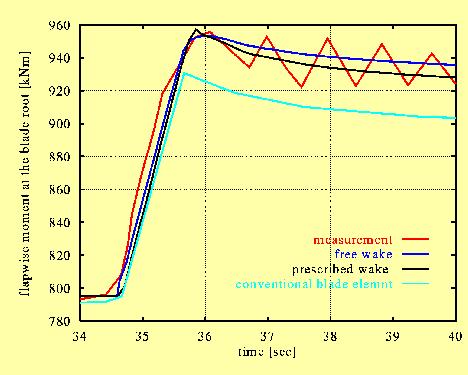
Full scale test cases: Tjaereborg rotor,
(a) Uwind=7.4m/s, pitch step from 3 to 1o.
(b) Uwind=12.5m/s, pitch step from 3.19 to 1o.
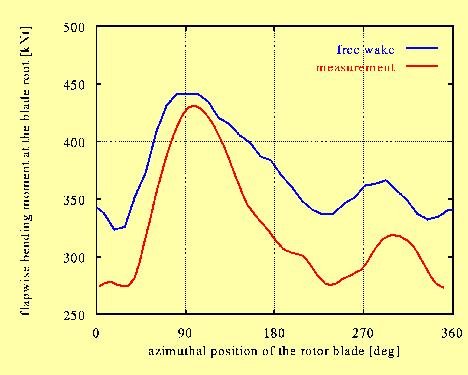
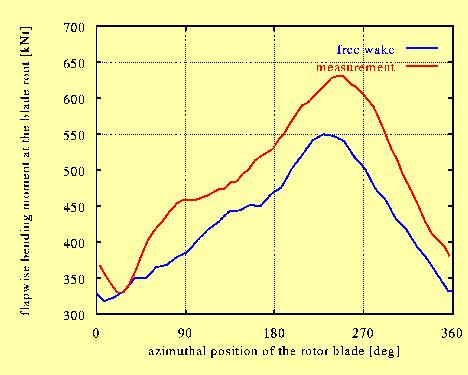
Full scale test cases: Tjaereborg rotor,
(a) Uwind=7.8m/s, yaw angle=54 o
(b) Uwind=8.3m/s, yaw angle=-51 o
Note the effect of the root vortex at almost 270o (case a) and 90 o (case b), the blade passes in front of the tower at 0o.
At high wind speeds yaw misalignment causes dynamic stall. In that case additional vortex particles are released from the leading edge. Combined with the trailing vortex shedding, a double wake is formed. Using such concepts, 2D as well as 3D runs were performed.
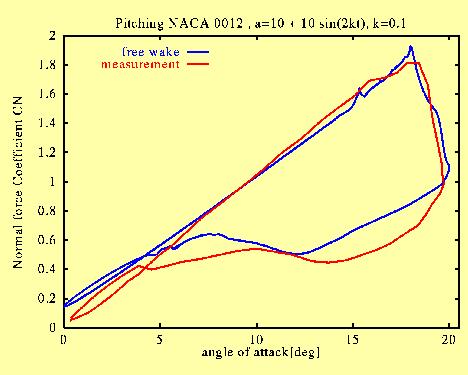
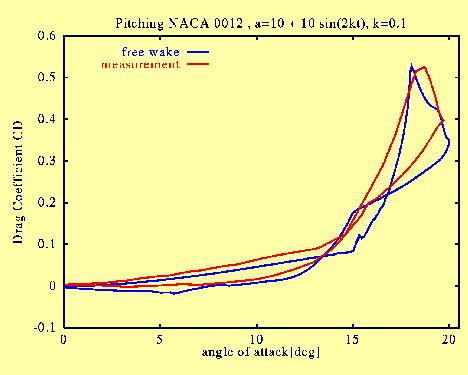
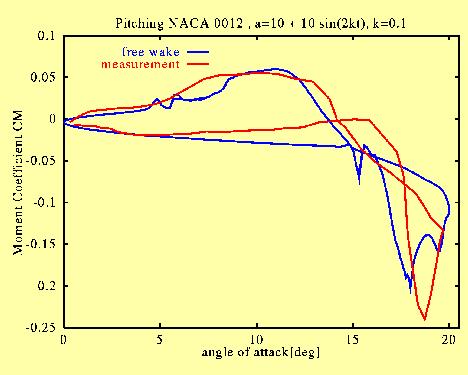
2D stalled case: pitching NACA 0012
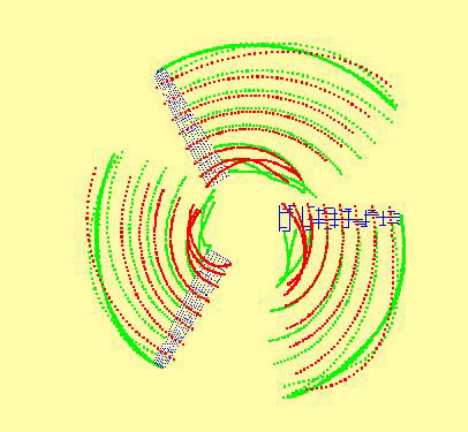
Wake in the case of stalled rotor operation.
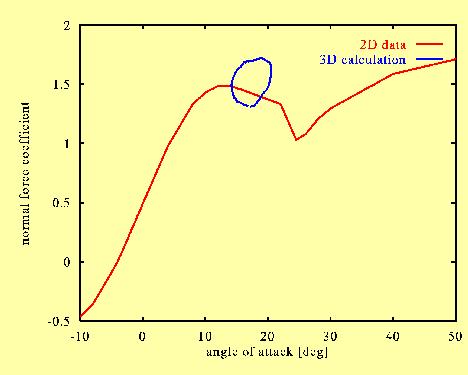
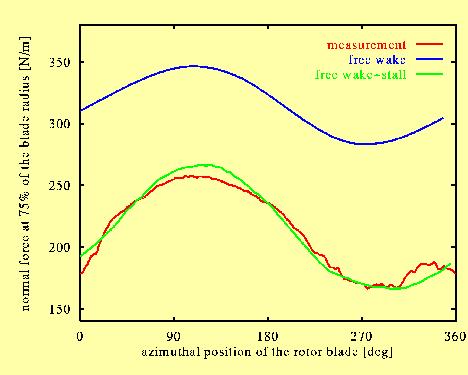
Full scale test case: Cranfield rotor, Uwind=21.4m/s, yaw angle=15o (blade passes in front of the tower at 270o)
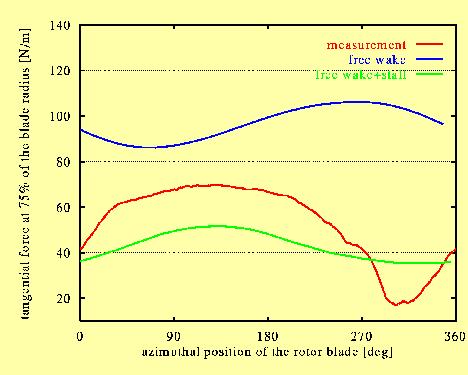
Full scale test case: Cranfield rotor, Uwind=21.4m/s, yaw angle=15o.
 Good predictions and correct trends are achieved using a free
wake model. GENUVP is a promising numerical model that can be
trusted as a tool for investigation of unsteady phenomena related
to wind turbines.
Good predictions and correct trends are achieved using a free
wake model. GENUVP is a promising numerical model that can be
trusted as a tool for investigation of unsteady phenomena related
to wind turbines.
 The relatively high computational cost is the basic draw back
of GENUVP, but its usage as a reference tool provided us with
the guidelines to finalize RAFT, an engineering tool.
The relatively high computational cost is the basic draw back
of GENUVP, but its usage as a reference tool provided us with
the guidelines to finalize RAFT, an engineering tool.
|
|
|
|
|
|